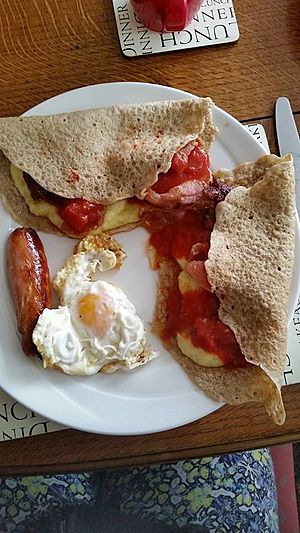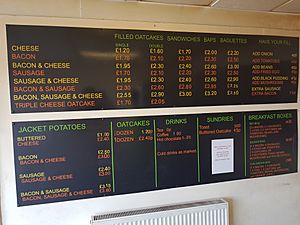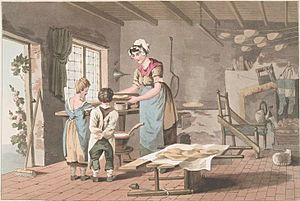Staffordshire oatcake facts for kids

A breakfast consisting of two Staffordshire oatcakes filled with cheese, tomatoes, and back bacon, served with a fried egg and a sausage.
|
|
| Type | Pancake |
|---|---|
| Place of origin | England |
| Region or state | Staffordshire |
| Main ingredients | Oatmeal |
A Staffordshire oatcake is a special kind of pancake. It's made from oatmeal, flour, and yeast. This mix makes a thick, flat pancake. People cook it on a hot plate called a griddle or "bakstone."
This oatcake is a local favorite. You'll find it mainly in the North Staffordshire area of England. It's especially popular in Stoke-on-Trent. People from outside the area often call them Staffordshire oatcakes. This is because they were first made in Staffordshire and Cheshire. But if you're from around there, you just call them "oatcakes."
Contents
History of Oatcakes
Long ago, it was common to buy oatcakes right from people's homes. They would sell them from a window to customers on the street. One famous place was called the "Hole in the Wall" in Stoke-on-Trent. It closed for a while but reopened in 2019.
Today, you can find many small shops selling oatcakes. You can buy them ready to eat with fillings. Or you can buy a pack of six or twelve to take home. Bigger companies also make oatcakes. They sell them to supermarkets and other large stores.
Oatcakes can be a quick and easy meal. Shops in the area often offer them with tasty fillings. Popular choices include cheese, tomato, onion, bacon, sausage, and egg. Some people like sweet fillings too. These can be golden syrup, jam, or banana. But this is less common for traditionalists.
People usually reheat oatcakes by steaming them. They put them between two plates over a pot of boiling water. Nowadays, many use a microwave. Some prefer to fry them in butter or grill them.
The Staffordshire oatcake is different from the Scottish oatcake. Scottish oatcakes are more like a hard biscuit. Both are made from oatmeal, but they are very different foods. The Staffordshire oatcake has been around since the 1800s. Back then, people baked them on a hot plate over an open fire.
Different Kinds of Oatcakes
Derbyshire Oatcakes
Derbyshire oatcakes are quite similar to Staffordshire ones. They use a similar recipe. However, they are usually bigger and thicker. For example, a recipe that makes four Derbyshire oatcakes might make twelve Staffordshire ones.
Oatcakes from Lancashire and Yorkshire
A Lancashire oatcake looks a bit like a Derbyshire oatcake. But it's made without wheat flour or milk. It's shaped like a long oval, about 11 by 6 inches (28 by 15 cm). One side is smooth, and the other is rough. People traditionally cook it on a bakestone.
You can eat it soft, rolled up with a filling like a pancake. Or you can dry it until it becomes a crispy cracker. The dried version with a beef and cowheel stew is called "stew and hard." This type of oatcake was once common in Lancashire. Now, it's not seen very often. The same cake is also made in West Yorkshire and Craven. Sometimes it's called the Pennine oatcake. In Yorkshire, the recipe often includes about 20% buttermilk.
In Lancashire and Yorkshire, oatcakes were a main food until around 1910.
Cooking Tools for Oatcakes
In Lancashire and West Riding of Yorkshire, the cooking plate was called a bakstone. Originally, it was a flat, oval stone. It was about 1.5 inches (4 cm) thick. People would place it over an open fire. Later, in the 1800s, cast-iron plates replaced the stones. But the name "bakstone" stayed the same. In big houses, bakstones were built next to the chimney. They had a firebox underneath an iron plate.
In the 1700s, people mixed the batter in a small wooden bucket. They didn't clean it. This helped the next batch of batter to ferment. By the 1800s, people started using baker's yeast. They also used porcelain or enamel pails for mixing.
The size of the ladle used to pour the batter changed. It depended on how much oatmeal cost. For many years, oatcakes traditionally cost one penny each. Or you could get 18 for a shilling.
Before about 1860, the way of making them was called "thrown oatcakes." The baker would sift oatmeal onto a "riddleboard." Then they poured a ladle of batter on top. They would spread it out in a circle. Next, they slid it onto a piece of linen on a "spittle" board. This board had a handle. The cake was then "thrown" (flipped) onto the bakstone. After that, the linen was taken away.
People used to make baking racks by turning a chair on its side. They would cover the legs with a white cloth.
Oatcakes made for drying were left until crisp. They were placed on a special rack called a "bread flake." "Flake" comes from an old word meaning a hurdle. Some flakes had wooden bars. Others had strings where each cake was laid. In some areas, this rack was called a "bread creel."
Oatcake Day Celebrations
Stoke-on-Trent held a special event called Oatcake Day. It took place on Sunday, August 8, 2010. This event led to other fun activities, like "Oatcake Camp."
|




